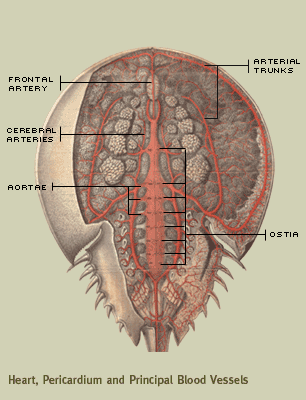The Circulatory System
The horseshoe crab's heart is a long tube that lies along the opposite side of the body from the nerve cord and extends almost the entire length of its body. On average, the heart rate of the horseshoe crab is 32 beats per minute.
It has eight pairs of slit-like openings, or ostia, each opening having two valves through which the blood enters the heart from the pericardial chamber. The blood is pumped forward and escapes through three pairs of aortae, one pair of cerebral arteries, and a frontal artery. (See the diagram of the blood flow for more.)
Two types of hemocytes exist in the blood of the horseshoe: an abundant number of granulocytes and a few cyanocytes. The granulocytes are responsible for the rapid clotting of blood, especially in the presence of bacterial endotoxins. The extreme sensistivity of these cells has generated the broad clinical use of horseshoe crab blood for endotoxin testing by the pharmaceutical industry (see Medical Uses for more).
